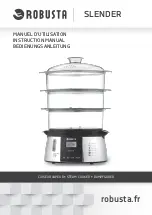
37
36
37
hands above the valve and wait until there is no vapour left. Only when the
safety valve has lowered the lid may be opened. This version is not suitable for
foaming or mashy food (such as soups, stews, legumes and pasta).
Attention:
If the locking pin has not sunk (the pressure is still in the cooker), you must
not open the cooker. Please wear gloves when opening the cooker in order to
avoid injuries.
In the case of mushy food such as rice pudding, potage etc. the cooker should
be slightly agitated in order to remove the air bubbles. NEVER OPEN THE LID
BY FORCE!
Cleaning the Safety Vent
To clean the safety vent, first loosen
the holding screw (see fig. 10). You
can then lift the safety vent out and
clean it thoroughly. Use the supplied
spanner for this purpose.
The safety vent may not be
divided!
Removing the Pressure control valve
To clean the silicone sealing ring, please remove the pressure control valve
(see fig. 6, page 33).
D
E
P
PL
CZ
H
RO
GR
BG
D
UK
F
I
Care and Maintenance
After use, wash your pressure cooker with hot water and a non-abrasive
washing-up liquid. The lid and rubber gasket cannot be washed in a dishwasher.
With stronger, more resistant soiling we recommend to soak them for a while.
Do not use any sharp or pointy objects for cleaning, even in case of heavy
soiling. Remove limescale residue by using vinegar.
The rubber gasket must
not be washed with washing-up liquid
. After
washing, the pot and the lid should be dried thoroughly and stored with the lid
facing upwards. It is not a good idea to put the cooker away with the lid
closed, as this will cause the rubber to deteriorate more quickly.
Basic Information
Screwed fittings can become loose over time. These can, however, easily be
tightened using a standard screwdriver. Induction stoves may sometimes
produce a buzzing noise during cooking. This is due to technical reasons and
does not indicate a fault of the cookware. The pot‘s bottom diameter must
match the size of the cooking zone, otherwise the cooking zone (magnetic
field) may not respond to the pot‘s bottom, especially if the bottom diameter
is smaller. Preheat the cookware at no higher than a medium heat. Empty
cookware may reach temperatures of up to 500°C very quickly, particularly
on induction hobs.
Holding screw for safety vent
(marked red)
Silicon seal for pressure
regulating valve
fig. 10
















































